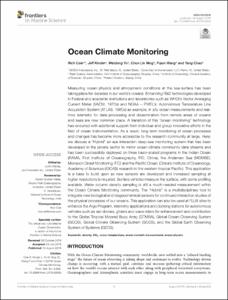Ocean climate monitoring.

View/
Average rating
votes
Date
2019Author
Cole, Rick
Kinder, Jeff
Yu, Weidong
Ning, Chun Lin
Wang, Fujun
Chao, Yang
Metadata
Show full item recordAbstract
Measuring ocean physics and atmospheric conditions at the sea-surface has been
taking place for decades in our world’s oceans. Enhancing R&D technologies developed
in Federal and academic institutions and laboratories such as WHOI’s Vector Averaging
Current Meter (VACM, 1970s) and NOAA – PMEL’s: Autonomous Temperature Line
Acquisition System (ATLAS, 1980s) as example, in situ ocean measurements and realtime
telemetry for data processing and dissemination from remote areas of oceans
and seas are now common place. A transition of this “ocean monitoring” technology
has occurred with additional support from individual and group innovative efforts in the
field of ocean instrumentation. As a result, long-term monitoring of ocean processes
and changes has become more accessible to the research community at large. Here;
we discuss a “Hybrid” air-sea interaction deep-sea monitoring system that has been
developed in the private sector to mirror ocean-climate community data streams and.....
Journal
Frontiers in Marine ScienceVolume
6Issue
Article 503Page Range
5pp.Document Language
enEssential Ocean Variables (EOV)
N/AMaturity Level
MatureDOI Original
10.3389/fmars.2019.00503Citation
Cole, R., Kinder, J., Yu, W., Ning, C.L., Wang, F. and Chao, Y. (2019) Ocean Climate Monitoring. Frontier in Marine Science, 6:503, 5pp. DOI: 10.3389/fmars.2019.00503Collections
The following license files are associated with this item:
 Repository of community practices in Ocean Research, Applications and Data/Information Management
Repository of community practices in Ocean Research, Applications and Data/Information Management
